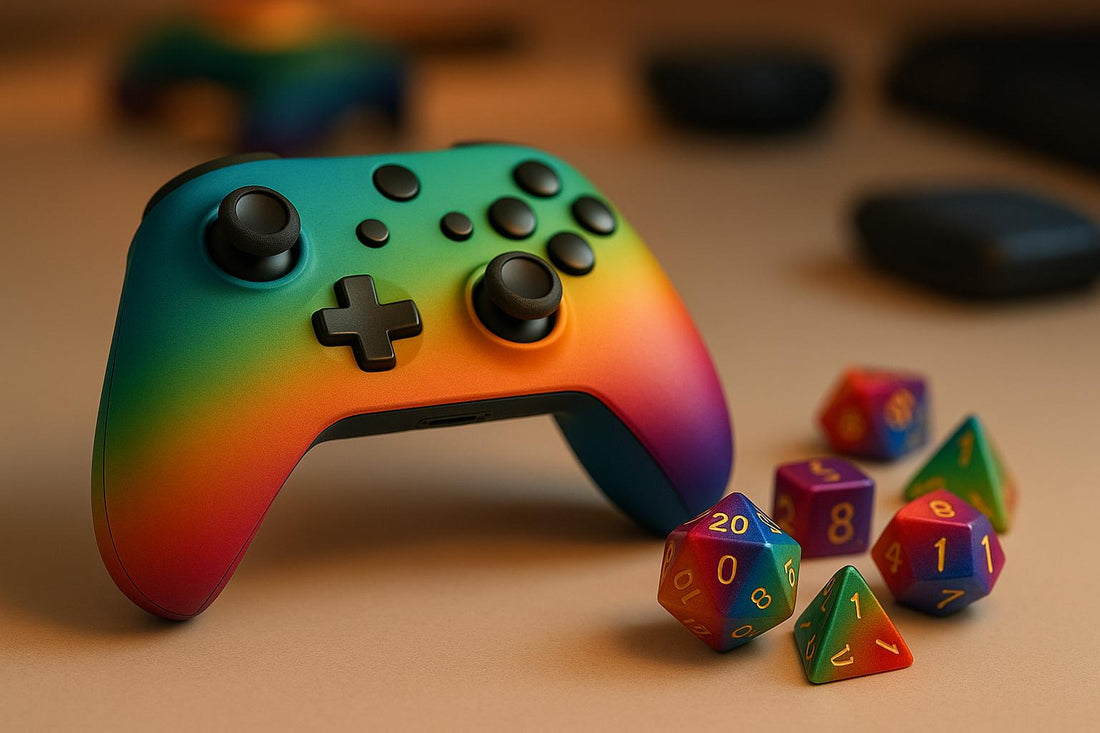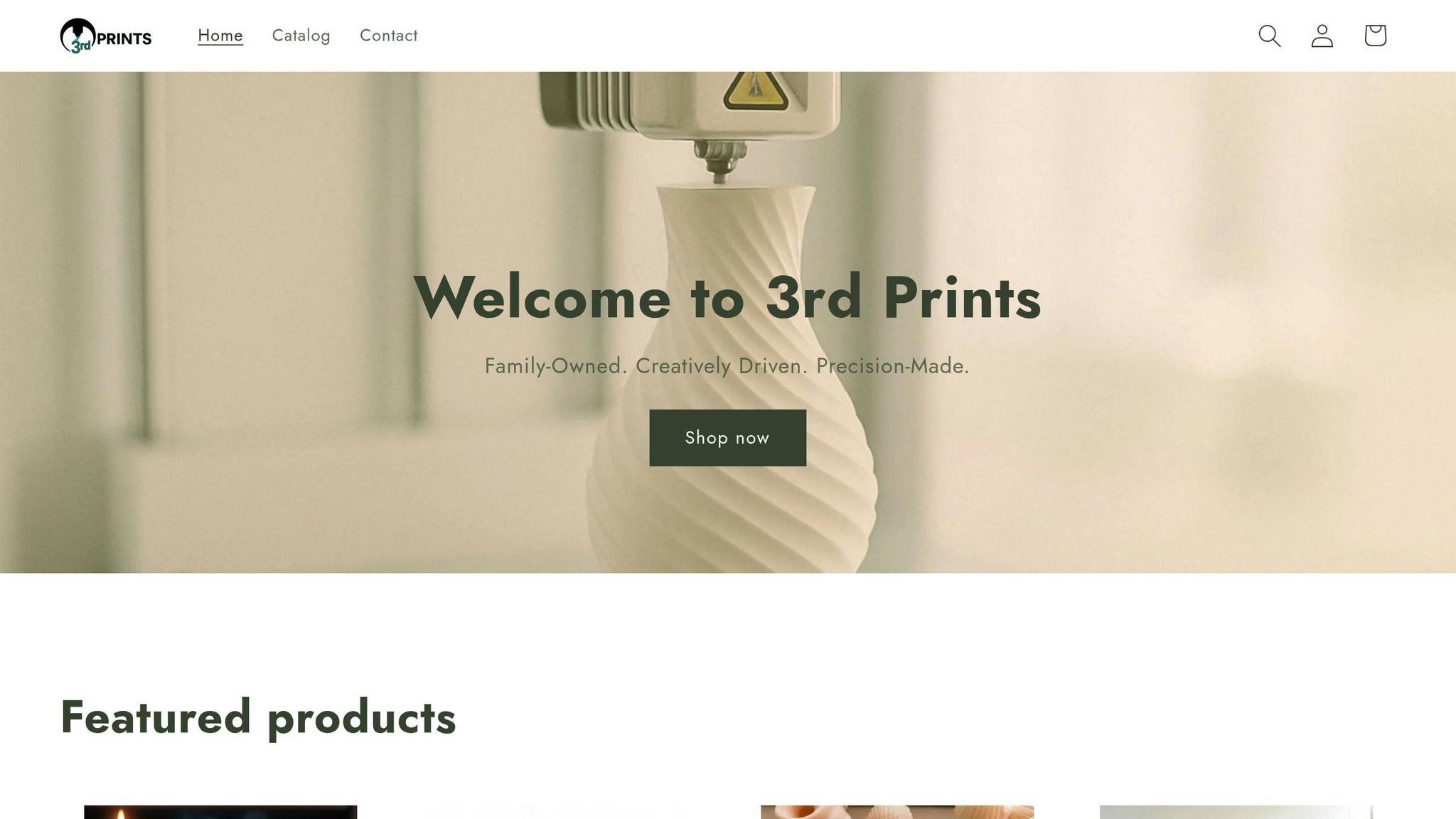
Custom Color FAQs for 3D-Printed Gaming Gear
Custom colors for 3D-printed gaming accessories let you personalize your setup and improve functionality. Whether you’re creating a dice tower, keychain, or tabletop accessory, custom colors can help you stand out while staying organized. Here’s what you need to know:
- Color Methods: Use multicolor filaments, dual-extruder printing, or post-print techniques like painting, hydrographics, or vinyl wrapping.
- Durability: Factors like UV exposure, handling, and temperature affect how long colors last. Proper care (e.g., storing in cool, dry spaces) extends lifespan.
- Advanced Options: Full-color 3D printing methods like binder jetting or material jetting offer detailed, vibrant designs.
- Ordering Tips: Share references (e.g., Pantone codes) for precise color matching. Test prints help ensure accuracy.
Custom colors not only elevate your gaming gear’s look but also make it functional and long-lasting. For personalized solutions, services like 3rd Prints offer tailored options to match your vision.
4 ways to add color to your 3D prints WITHOUT paint or multi-material. 3D Printed Tiny Traffic Cones
How to Add Custom Colors to 3D Prints
Adding custom colors to 3D-printed gaming accessories not only boosts their visual appeal but can also enhance their functionality. Whether you're looking for vibrant designs or interactive features, there are several ways to achieve the perfect look for your gaming gear. Each technique has its own benefits, so it's worth exploring the options to find the one that works best for your specific needs.
Multicolor Filaments and Direct Color Printing
Multicolor filaments are a straightforward way to achieve stunning effects without extra equipment. These filaments come with built-in color variations, creating natural gradients during the printing process. For instance, silk PLA filaments add a shiny, light-reflective finish, making them perfect for dice towers and other gaming accessories that benefit from a bit of flair.
Color-changing filaments take things a step further by adding an interactive element. These thermochromic materials change color in response to heat or touch, making them a fun option for gaming gear that reacts to its environment.
Dual-extruder printing allows for precise two-tone designs by using two separate filament feeds simultaneously. This method is ideal for adding contrasting details like logos, text, or accents to your accessories. The printer automatically switches between colors based on the digital design, making it a seamless process.
Filament swapping is a budget-friendly alternative for single-extruder printers. By manually changing the filament at specific layers, you can create distinct color zones within a single print. While it requires a bit more effort, this technique is an economical way to achieve multicolor prints without investing in advanced equipment.
Adding Colors After Printing
If you prefer to add colors after printing, there are plenty of options to customize your gaming accessories:
- Acrylic painting is one of the easiest and most accessible methods. Applying a primer first ensures the paint adheres well, especially on smooth PLA surfaces. Acrylic paints dry quickly and come in a wide variety of colors, making them great for detailed work like highlighting raised features or adding team colors.
- Spray painting is ideal for larger accessories, providing even coverage and a professional finish. Automotive-grade primers and paints are particularly durable, standing up to regular use. For the best results, apply several thin coats instead of one thick layer, and always ensure proper ventilation during the process.
- Hydrographics (or water transfer printing) can achieve intricate patterns and designs that would be impossible with direct printing. This technique transfers a printed film onto your 3D object using water. Popular patterns for gaming gear include carbon fiber, wood grain, and camouflage.
- Vinyl wrapping offers a removable and versatile option for customization. High-quality vinyl films can conform to curved surfaces, making them suitable for keychains or flat accessories. Plus, you can switch designs easily for seasonal themes or new gaming campaigns.
- Brush-on coatings like Plasti Dip not only add color but also create a rubberized finish that improves grip. This is especially useful for accessories that are handled frequently, combining both style and practicality.
Full-Color 3D Printing Methods
For those looking to integrate colors directly into the manufacturing process, advanced 3D printing technologies provide impressive results.
- Binder jetting technology uses colored binding agents applied to powder layers, producing photorealistic colors and smooth gradients. This process works similarly to inkjet printing but builds the design in three dimensions, making it ideal for detailed gaming accessories.
- Material jetting employs liquid photopolymers in multiple colors, curing each layer with UV light to create highly detailed and vibrant objects. This method delivers smooth finishes and precise color reproduction, which is perfect for intricate miniatures or accessories with complex designs.
- Multi-material printing allows for the use of various colored materials in a single print job. Advanced printers can handle multiple materials at once, enabling you to create accessories with different textures, colors, and even functional sections. For example, you could use specific colors to indicate different functions or features.
Choosing the right method depends on factors like color accuracy, durability, cost, and how much time you're willing to invest. While direct color printing methods offer convenience and precision, post-processing techniques provide greater flexibility for customization. Each approach has its strengths, so consider your gaming gear's design and purpose when deciding on the best option.
How Long Custom Colors Last
The lifespan of custom colors largely depends on the materials used, the techniques applied, and how well they’re cared for.
What Affects Color Durability
The quality of materials is a key factor in how long custom colors stay vibrant. Premium paints and coatings tend to last longer and perform better than cheaper options, especially on items that get a lot of use.
Exposure to UV light is another major factor. Prolonged time in direct sunlight or under bright indoor lighting can break down pigments, causing colors to fade noticeably over time.
Frequent handling also takes its toll. Oils from hands and the mechanical stress of regular use can wear down surfaces faster.
Temperature changes can be another culprit. If you store 3D-printed gear in places like garages or attics, where temperatures swing widely, you risk damaging the surface. Extreme heat, in particular, can even alter the properties of some specialty materials.
Humidity levels also matter. High humidity can soften or cloud paint finishes, while overly dry conditions can make coatings brittle and prone to cracking.
These factors underscore the importance of proper care to extend the life of custom colors.
How to Keep Custom Colors Looking Good
To preserve the vibrancy of custom colors, consider these care tips:
- Store your items properly. Keep your gaming accessories in a cool, dry, and shaded space to minimize fading and surface damage.
- Clean regularly. Use a damp microfiber cloth to wipe down surfaces, avoiding harsh chemicals that could strip the finish. For added protection, apply a clear sealer or polyurethane coat. Matte finishes are especially useful for hiding minor scratches from regular handling.
- Rotate usage. If you have multiple accessories, alternate between them. This prevents any single piece from experiencing excessive wear and tear.
- Perform touch-ups. Keep a small amount of matching paint on hand for quick fixes to chips or scratches before they worsen.
sbb-itb-c5cd7d3
Color Matching and Custom Orders
Getting the perfect color in 3D printing involves understanding both the possibilities and the limitations of the technology.
Color Matching Options and Limits
Most services rely on standardized systems like Pantone or RAL to achieve consistent color results. These systems help ensure your custom dice tower or gaming accessory aligns with your vision. However, the final outcome is influenced by the materials and printing methods used.
For example, PLA and PETG materials offer a wide range of color options and are easy to dye, making them ideal for matching specific shades like your favorite team colors or a brand palette. Resin, on the other hand, excels at capturing fine details but comes with more limited color choices.
Specialty finishes, such as metallics or iridescent effects, present additional challenges. These finishes can appear differently depending on lighting and viewing angles, which may affect the final look. Additionally, temperature resistance plays a role in color durability, as some pigments may fade or shift when exposed to heat or sunlight over time.
How to Order Custom Colors
Once you're familiar with the color options, placing a custom order is a straightforward process, but it requires attention to detail.
Start by providing reference materials. This could include Pantone numbers, photos of items you want to match, or even physical samples sent by mail. The more precise your references, the closer the final product will align with your expectations.
Many professional services, like 3rd Prints, offer digital previews before production begins. These previews give you a general idea of the design, though they might not fully reflect the finer details of the final product.
For particularly intricate color matching, requesting sample pieces is a smart move. Some services will create test prints in your specified colors, allowing you to see and feel the materials before committing to a full order. While this adds to both cost and production time, it significantly improves accuracy.
The approval process involves back-and-forth communication. You'll review digital mockups, request changes, and give final approval before production starts. This step is especially important for designs with multiple color zones or gradients.
Keep in mind that custom orders take longer than standard ones. Simple color adjustments might add 3-5 business days, while more complex designs or specialty finishes could extend timelines by 1-2 weeks. If you're planning to use custom gaming gear for a specific event or tournament, make sure to account for these lead times.
Lastly, some services may have minimum order requirements for specific shades. While ordering a single item is often possible, larger orders typically offer better value and ensure consistent results across all pieces.
Custom Colors at 3rd Prints

At 3rd Prints, we take pride in offering personalized color options for every 3D-printed gaming accessory. Whether you're looking for fidget toys, keychains, dice towers, or themed tabletop gaming items, our family-owned ecommerce store specializes in bringing your ideas to life. Have a specific color scheme in mind? Our team is here to collaborate with you and create tailored solutions that match your vision. Reach out to us today to explore how we can craft accessories that perfectly align with your gaming style. This dedication to personalization goes hand in hand with our focus on quality and durability mentioned earlier.
Conclusion
Custom colors transform 3D-printed gaming gear into one-of-a-kind creations that reflect your personality. Whether you're coordinating with your favorite team’s colors, designing a unified tabletop gaming setup, or just looking to stand out in your gaming circle, custom colors open up a world of creative options.
But it’s not just about looks - durability plays a huge role too. With today’s advanced materials and proper care, those vibrant custom colors are built to last.
Thanks to full-color 3D printing, you also get incredible realism and precision. This technology brings your vision to life in detailed, unique pieces that feel truly personal.
Custom colors go beyond aesthetics - they’re a form of personal branding. They give you the chance to showcase your individual style and make your gaming gear unmistakably yours.
At 3rd Prints, we take pride in turning your ideas into reality. As a family-owned business, we treat every custom color request with care and expertise. From dice towers and keychains to themed tabletop accessories and fidget toys, we’re here to bring your colorful gaming dreams to life with unmatched attention to detail and creativity.
FAQs
How can I make sure the custom colors on my 3D-printed gaming gear last a long time?
To keep your custom colors looking bold and lasting longer, it’s essential to prep your 3D-printed gear the right way. Start by sanding the surface to smooth out imperfections, then apply a primer. This not only helps the paint stick better but also reduces the chances of fading over time. Opt for high-quality paints made specifically for plastics, like acrylics, to ensure the colors hold up well and resist wear.
If durability is a priority, consider printing with tougher filament materials like PETG, which offer better impact resistance compared to PLA. For items exposed to sunlight or rough conditions, using UV-resistant filament colors can help preserve the finish. By following these steps, your gaming accessories will stay colorful and ready to perform!
How can I ensure accurate color matching for my custom 3D-printed gaming accessories?
To get spot-on color matching for your custom 3D-printed gaming accessories, start by locking in the exact shade you want. You can use tools like digital color pickers or physical color guides, such as the Pantone Matching System (PMS), to nail down the precise color code for your design.
Once you've got your color, choose high-quality filaments that align closely with your selected shade. Don’t overlook your printer settings - fine-tuning parameters like temperature and extrusion can make a big difference in achieving accurate colors. With the right combination of color selection and printer calibration, you’ll be able to produce gaming accessories that bring your vision to life.
What are the pros and cons of using multicolor filaments compared to painting or dyeing for adding color to 3D-printed gaming accessories?
Using multicolor filaments streamlines the process by incorporating colors directly into the printing phase, cutting out the need for extra steps afterward. This approach works well when speed matters, but it does come with trade-offs. Issues like color bleeding or limited control over where colors land can make it less precise. It’s a practical option for straightforward designs where perfection isn’t the main goal.
In contrast, post-printing techniques such as painting or dyeing offer much more control and allow for detailed color work, making them perfect for intricate gaming accessories or detailed models. The downside? These methods take more time and require a steady hand. There’s also a slight risk of uneven results or even damaging the surface if not done carefully. Deciding between these approaches really comes down to what matters most - speed or precision.
